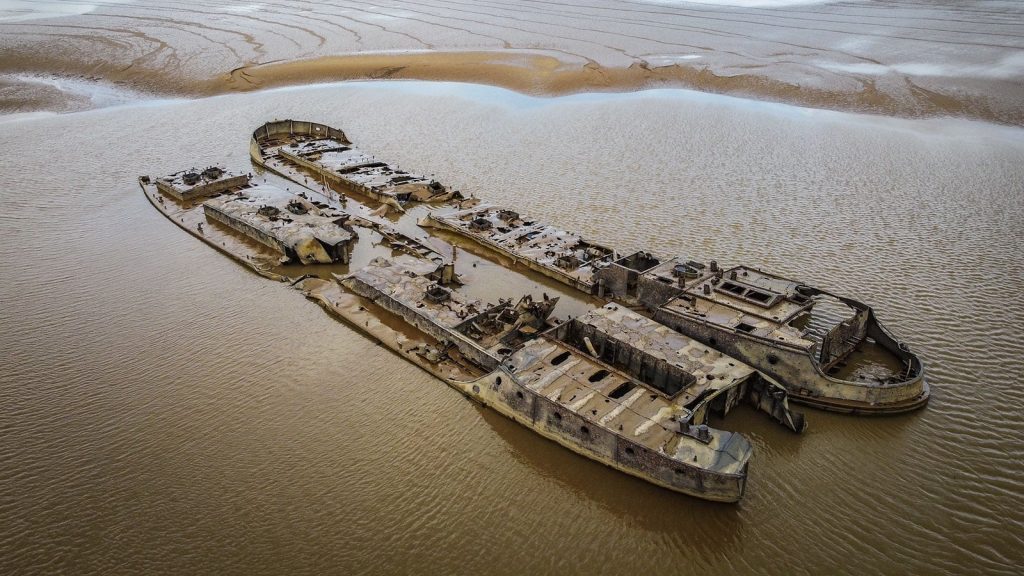On the night of October 25th, 1960, in thick fog on a treacherous stretch of the River Severn near Sharpness Dock tragedy struck. Two oil tankers, the Arkendale H and Wastdale H, operated by John Harker Ltd, collided and hit a pillar of the Severn Railway Bridge, killing five sailors.
Destined for Worcester, the Wastdale H, skippered by Captain James Dew, was carrying 350 tons of volatile petroleum spirit from Avonmouth. The Arkendale H, skippered by George Thompson, carrying 300 tons of black oil or tar, collided and brought down a span of the rail bridge that linked Sharpness to Lydney.
That night 16 ships had been travelling from Avonmouth to Sharpness on the incoming tide, though the thick fog at Sharpness reduced visibility to a few metres.
Unknown to skipper George Thompson, crewmen on the Wastdale H had secured a mooring rope to both barges which made it impossible to steer the barges to the safety of Sharpness Piers in the fierce current. A girder from the bridge fell onto the Arkendale, slicing through the tanker just forward of the wheelhouse.
Fire crews on both sides of the river were dispatched, including Dursley, Stroud and Wotton-under-Edge, but conditions were so bad that the chief officer denied the crew permission to do any firefighting.
Eyewitness, maritime historian and author Chris Witts, then aged just 16 and working as a deckhand on the tanker Wyesdale H, recalled: “Suddenly there was this big ‘whoosh’ and we looked towards where the sound was and we saw this big orange glow, so fierce it was burning off the fog.

“We all managed to get into Sharpness safe and sound apart from these two, the Arkendale H and the Wastdale H, and sadly the big tide got hold of the two vessels and pushed them sideways up towards the Severn Railway Bridge.”
The lethal cargo of the two vessels, floating on the river, subsequently ignited, as maritime historian, Paul Barnett, explained; “They hit pier 17 [of the bridge] and in doing so brought that span down. It collapsed on to the vessels and sadly five men went into the river, and at that time it [the surface of the river] was burning from one bank to the other.”
Chris Witts added: “George [Thompson] goes back after his men, he knows they are on fire, they are sinking as well, and two of his crewmen are stood on the stern end – they were non-swimmers and frightened to death – and George gives them a life ring each and says ‘jump’.”

Crewman Jack Cooper, clinging to a stake on the sandbank, was rescued but was in great pain as one of the boat’s propellors had cut his back when he leapt from the vessel.
“There were three survivors,” added Mr Barnett. One of the crewmen was attracted to a light from a house on the western side of the river and managed to swim there.”
The following morning the fire service navigated the treacherous path across the river’s mud flats at low tide to search for missing crewmen: “To get out there they had to walk through the mud, carrying ladders, portable pumps, hoses and it was a hell of a job. They were out there purely to look for missing crewmen. Five men had been killed that night, but they didn’t find them,” said Mr Witts.
The five sailors who lost their lives were Percy Simmonds, Malcolm Hart, 17, mate Jack Dudfield, 46, engineer Alex Bullock, 40 and second engineer on the Arkendale H, Robert Nibblett 25.
Photographer David Ireland, now aged 92, arrived at the scene at first light the following morning with his press camera using glass plate negatives, and told Stroud Times: “The first I knew of it was when I was having my breakfast and listening to the BBC news. I quickly joined reporters Brian Cooper and John Cox and set off to Purton where we were ferried to the wrecks at low tide on a boat – I think we paid ten shillings.

“It was an eerie scene when we arrived – the fog had lifted – and the tankers were still smouldering.”
Five days after the collision, explosives were used to blow holes in the wrecks to stop them floating away on a large tide, and the remains of the tankers are still visible at low tide off Purton, even after more than 47,000 rise and falls of the River Severn’s exceptionally high and low tides of the past 65 years.

Demolition of the rail bridge began in August 1967, starting with the spans being removed from the bridge and laid on the mud banks. In May 1968 the main demolition work was completed after using explosives, but it took a further two years to clear the debris.

Memorial plaques for the disaster were unveiled at Purton and Lydney Docks in October 2010, to mark the 50th anniversary.

In subsequent years Mr Witts kept in touch with the families of those involved in the disaster and recalls the human cost: “We had five families missing their loved ones. Their lives were wrecked. Malcolm Hart was a year older than me and recently I met his two sisters. They told me how their lives were wrecked losing their brother, and their parents losing their son.
“I know from personal experience that George Thompson was a broken man inside. He told me the story on a number of occasions, but he became quite emotional as he went on telling me the story.”







